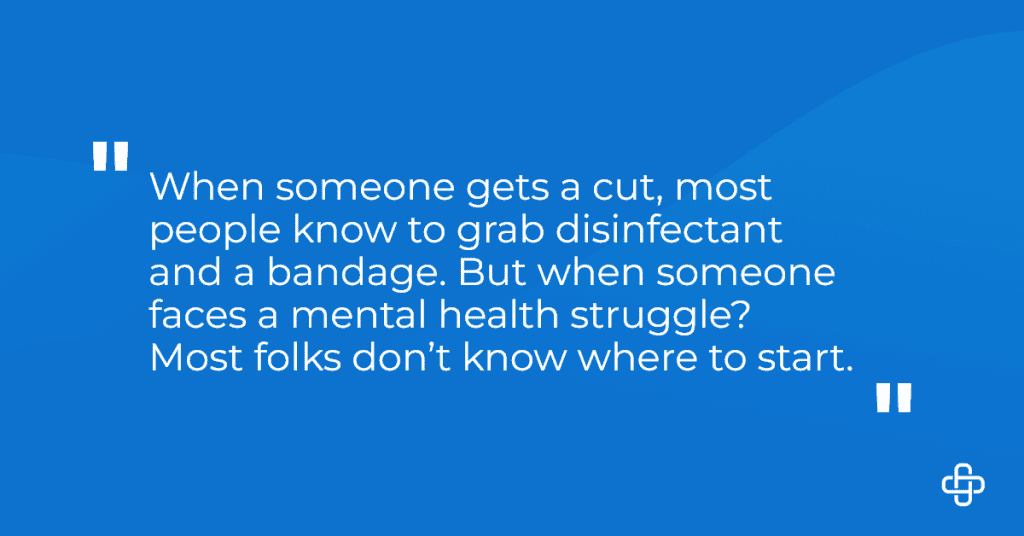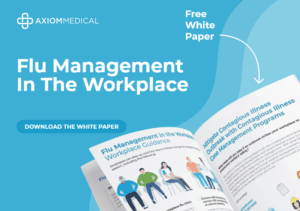Mental health issues usually don’t just disappear when ignored. Instead, they tend to snowball into diagnosable issues like depression, and in worst case scenarios, suicide. So, like any other safety concern, mental illness needs to be addressed in a timely fashion. You wouldn’t leave a flesh wound unattended, right?

Below are 7 strategies to get you thinking about different methods for keeping the folks who make up your workplace mentally safe and sound.
- Create a Supportive Workplace Culture
Stigma and suicide go hand-in-hand. Therefore, employees should feel confident that they won’t face judgment or repercussions for seeking help. Here’s what leaders can do to establish a positive environment:
- Normalize conversations around mental health by offering regular training or talks that highlight the importance of mental well-being.
- Model openness as leaders. Share personal stories (as appropriate) to show that it’s okay to discuss struggles and seek support.
- Encourage peer support programs where employees can connect with colleagues who are trained to provide initial empathetic listening.
Above all, a supportive culture requires trust. Try to give employees as many opportunities as possible to trust you.
- Recognize Warning Signs
Unlike a visible external injury that could result in death, mental health issues are not always clear from the outside. And because shame so often accompanies mental health issues, workers may be actively concealing it. Luckily, Managers and co-workers often spend significant time with employees, putting them in a unique position to spot early warning signs of depression or suicidal ideation. Some common indicators include:
- Changes in behavior, such as withdrawal or noticeable disinterest in social interactions.
- Declines in work quality, attendance issues, or missed deadlines.
- Off-hand statements expressing hopelessness.
- Extreme mood swings, irritability, or uncharacteristic outbursts.
It’s vital to approach such situations with compassion and confidentiality, not judgment. A kind, private check-in conversation can make a big difference for someone who is struggling.
- Provide Accessible Mental Health Resources
When someone gets a cut, most people know to grab disinfectant and a bandage. But when someone faces a mental health struggle? Most folks don’t know where to start. Which is why employers should make mental-health tools easily accessible, just like they do band-aids or gauze. Consider implementing or enhancing the following support systems:
- Employee Assistance Programs (EAPs): EAPs can offer counseling services, referrals, and support for various mental health challenges.
- Mental health days: Encourage employees to take time off when they need to focus on their mental well-being, just as they would for physical health.
- Digital tools and apps: Partner with mental health platforms that offer online therapy, stress management resources, or self-help tools.
Ensure resources are communicated clearly and regularly so employees know how to access them when needed. Visibility and ease of access are key.
- Promote Work-Life Balance
Most of us know from experience that prolonged periods of intense work can take a toll on mental health. Employers must actively support work-life balance by:
- Setting clear boundaries between work and personal time. For example, discourage after-hours emails unless urgent.
- Offering flexible scheduling and remote work options where possible.
- Encouraging employees to take regular breaks, use their vacation time, and avoid burnout.
Taking care of mental health starts with creating an environment where employees feel they can step away when needed to recharge. Additionally, allowing employees to recharge can help build resilience that prevents mental health issues in the first place.
- Collaborate With External Experts
Finally, don’t hesitate to seek external support. Work with mental health professionals or organizations to develop strategies, provide on-site counseling, or conduct specialized training. Partnerships with organizations like the American Foundation for Suicide Prevention or local mental health nonprofits can bring expertise and credibility to your efforts.
Get the ball rolling by attending our webinar Workplace Suicide Prevention: Real Stories, Real Solutions featuring Axiom’s Director of Behavioral Health and EAM, Sarah Hathaway, and a personal testimony about workplace culture shifts surrounding mental health by Arcxis’s Chief Human Resources Officer, Rod Branch.










